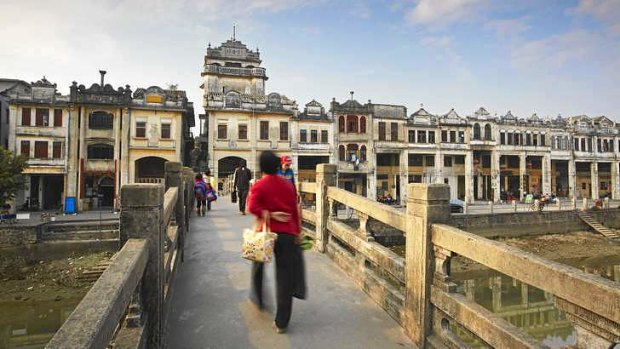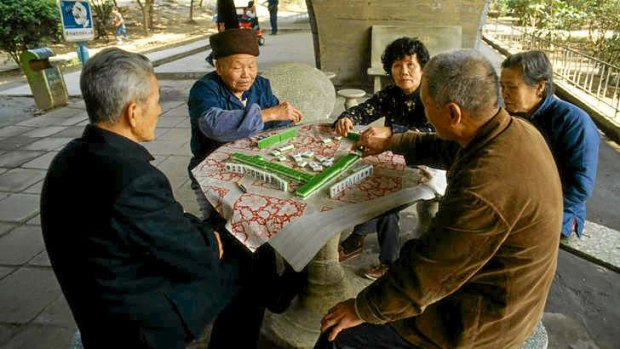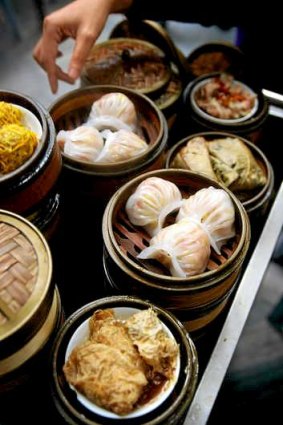By Lee Tulloch

People crossing the bridge in front of colonial architecture, Chikanzhen, Guangdong.Credit: Getty Images
Lee Tulloch savours luxury and heritage sights on a brief layover in Guangzhou.
The last time I was in Guangzhou I stayed in a hotel that was being built over my head. That was 30 years ago, and there has been a lot of construction since then. But the city is in many ways still the beautiful city I recall, despite much of its airspace being unrecognisable.
Away from the skyscrapers, it is still very much a place of gardens, fascinating old lanes and wonderful colonial buildings built along a wide river. It may have an estimated 18 million residents, but parts of it feel very local and personal, even for a stranger.

Playing mahjong is a popular pastime in Guangzhou.Credit: Alamy
I have the opportunity to visit Guangzhou again on a stopover between Sydney and Paris when I fly China Southern Airlines, which has its base in Guangzhou. The introduction of free, on-arrival 72-hour visas for passengers transiting in China has meant that it's easy for me to break my journey to Europe and spend some time exploring China's third-largest city.
I've only got 24 hours this time, and have no idea where to start, so I ask Creative Holidays to help plan an itinerary for me with a local guide. I'm interested in the old parts of the city, in markets and, most of all, in sampling the famous Cantonese cuisine.
My guide, Raymond, meets me when I'm through customs. Outside the vast airport terminal it's warm and very polluted. Although I'm familiar with the pollution in Shanghai and Beijing, I imagined that this more southern city, which is only two hours by train from Hong Kong, would be spared it. But Guangzhou is an important shipping port and therefore is surrounded by factories.

Yum Cha served at famous restaurant Panxi, along Liwan Lake.Credit: Getty Images
Raymond insists, though, that the pollution is not typical, that these "wet days" are "special weather" and only occur in spring.
I can't say that Guangzhou's traffic is horrible, like it can be in other Chinese cities. There are ring roads without traffic lights to ease the congestion. But Raymond tells me that every family in Guangzhou has 1.5 cars. I don't doubt it - we drive past streets and streets of garages and shops selling auto parts, the prices set by the government. There's now a waiting list if a resident wants a petrol-fuelled car, but those buying electric cars are permitted to have them immediately.
It's late afternoon, so I'm taken directly to my hotel, the new Mandarin Oriental in the Tianhe district, which is full of office blocks and shopping malls, not especially picturesque. But the hotel is glamorous, full of fascinating art, including a "spirit tree" in the lobby, which is constructed out of 200 real trees, and a cake shop full of enticing macaroons.
My room is supremely comfortable - a corner Mandarin Room with floor-to-ceiling windows and a big, puffy bed right in the corner. I'm tempted to go straight to bed after the flight, but I've been invited to have dinner at the hotel's Cantonese restaurant, Jiang by Chef Fei, and I want to get as much local food in as possible.
I'm served many of the classical dishes, starting with a delicate soup of steamed quail and pork, and ending with the best egg tarts I've ever eaten.
After dinner, I retire to my room and splash around in the egg-shaped freestanding bath that has views of the neon cityscape. I've only been here a few hours, but already I'm feeling great. Several hours of deep sleep follow.
I have just enough time in the morning to scoff down a few more Cantonese delicacies from the vast breakfast buffet in the hotel's Ebony restaurant, before Raymond and driver meet me and take me on a quick orientation tour of the city. Because I've asked to do the things locals do, we only stop for a short time to look at the new buildings of which Guangzhou is so proud, such as the Canton Tower, briefly the tallest building in the world. We also whiz past the spectacularly beautiful 19th-century Chen Clan Academy, which is one of the city's most popular tourist attractions.
We do stop on tiny (300-metre-long) Sharmian Island, which sits in the middle of the Pearl River and was once a strategic defence base and home to the mansions of wealthy traders. Many of the fantastic old colonial buildings here are beginning to be restored - in this respect Guangzhou seems about a decade behind Shanghai.
There's a lush park in the centre around which many of the buildings are organised, and young soldiers do their exercises while old ladies look on. The most beautiful building along the park is occupied by a Starbucks - the future may look like this.
Raymond takes me to the riverside, which is abuzz with people doing their morning activities. There's a choir singing, while a group of women practise a graceful exercise, balancing soft balls on table tennis bats.
Couples dance the foxtrot under a big banyan tree to music coming from an old boom-box. Elsewhere, people play mahjong, badminton and musical instruments. It's absolutely delightful.
As we drive around, we pass the entrances to many old lanes, similar to those in Shanghai's French Concession, although seemingly occupying a bigger district. I don't have time to explore them, but I mark it down as something for next time.
We stop at the "old old street" (as opposed to the merely old street), which has had a market on it for centuries. It's the place to go for ingredients for herbal medicine. By this I mean sacks and sacks full of dried curiosities, such as deer feet, starfish and snakes. There are dozens of kinds of dried fungi. Not far from this is the pet market, selling goldfish, birds, turtles and cute puppies.
I've asked Raymond to show me some authentic shops, and he takes me to Shangxiajiu, a long street lined with cheap clothing and shoe stores. The clothing is ridiculously inexpensive (think $1 shoes) and I imagine items have come straight from one of the factories that ring the city. But it's mostly junk, featuring curiously askew rip-offs of famous brands. There's a busy bakery and restaurant, Lianxianglou, which dates from 1889, and this looks like a good place for a cup of tea.
We don't have time to go to one of the wholesale markets, which are organised around leather, pearls or clothing. If you've only got a day and interested in bargain shopping, a good idea might be to ask your guide to take you directly there. The markets are another "next time" on my list.
It's lunchtime, so we visit Panxi, a renowned old yum cha restaurant along the bucolic Liwan Lake. After a tea ceremony we order from a menu, which is apparently what the locals do, rather than choosing from carts.
Carts do come around, offering chicken feet and other delicacies, but they're infrequent, which explains why the locals don't wait.
After lunch, we walk along the lake and watch people eating congees off the "porridge boats" that are lined up along the shore.
We then drive to Beijing Lu, the pedestrian mall in the centre of town, which was a shopping street 1000 years ago. (Part of the old road is preserved under glass.)
In this district, there is better-quality shopping, certainly if you want inexpensive, young, groovy clothing. The high-end shops are all found in the glitzy new malls, one of which is attached to the Mandarin Oriental. I have a spare hour so I roam the shiny new levels, all occupied by the usual suspects - Armani, Prada, Miu Miu, Bally. The Chinese fly to Paris to buy their designer clothes and handbags - even with the airfare, it's cheaper than buying here.
I spend my last couple of hours in the Mandarin Oriental's opulent spa, indulging in a massage. This is followed by a snack and a glass of wine. Suitably blissed-out, I'm glad Raymond has returned to get me to the airport in one piece.
What's not to love about this day? Great food, gorgeous hotel, fascinating local culture, luxurious spa treatment equals Perfect Stopover.
The writer was a guest of the Mandarin Oriental Guangzhou, Creative Holidays and China Southern Airlines.
GETTING THERE
China Southern Airlines operates 31 weekly flights from Sydney, Melbourne, Perth and Brisbane to its Guangzhou hub in southern China and onward to almost 200 destinations in 35 countries. Economy sale fares are priced from $1486 year-round return to Paris. See csair.com.au.
TOURING THERE
Creative Holidays has a dedicated stopover program with a range of packages in Guangzhou. Spend four nights at Ocean Hotel priced from $549 a person. Package includes private day tour including TV Tower, Huacheng Square, Shamian Island, Six Banyon Temple, lunch and private transfers. Available for sale until July 31. See creativeholidays.com.
TRIP NOTES
MORE INFORMATION
Sign up for the Traveller Deals newsletter
Get exclusive travel deals delivered straight to your inbox. Sign up now.